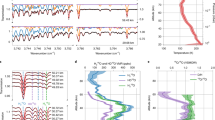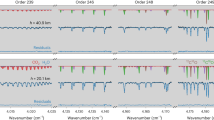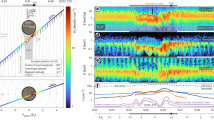Abstract
Molecular hydrogen (H2) is the second most abundant trace gas in the atmosphere after methane1 (CH4). In the troposphere, the D/H ratio of H2 is enriched by 120‰ relative to the world's oceans2,3,4. This cannot be explained by the sources of H2 for which the D/H ratio has been measured to date (for example, fossil fuels and biomass burning)5,6. But the isotopic composition of H2 from its single largest source—the photochemical oxidation of methane—has yet to be determined. Here we show that the D/H ratio of stratospheric H2 develops enrichments greater than 440‰, the most extreme D/H enrichment observed in a terrestrial material. We estimate the D/H ratio of H2 produced from CH4 in the stratosphere, where production is isolated from the influences of non-photochemical sources and sinks, showing that the chain of reactions producing H2 from CH4 concentrates D in the product H2. This enrichment, which we estimate is similar on a global average in the troposphere, contributes substantially to the D/H ratio of tropospheric H2.
This is a preview of subscription content, access via your institution
Access options
Subscribe to this journal
Receive 51 print issues and online access
$199.00 per year
only $3.90 per issue
Buy this article
- Purchase on Springer Link
- Instant access to full article PDF
Prices may be subject to local taxes which are calculated during checkout



Similar content being viewed by others
References
Novelli, P. C. et al. Molecular hydrogen in the troposphere: Global distribution and budget. J. Geophys. Res. 104, 30427–30444 (1999)
Ehhalt, D., Israel, G., Roether, W. & Stich, W. Tritium and deuterium content of atmospheric hydrogen. J. Geophys. Res. 68, 3747–3751 (1963)
Gonsior, B., Friedman, I. & Lindenmayr, G. New tritium and deuterium measurements in atmospheric hydrogen. Tellus XVIII, 256–261 (1966)
Friedman, I. & Scholz, T. G. Isotopic composition of atmospheric hydrogen, 1967–1969. J. Geophys. Res. 79, 785–788 (1974)
Gerst, S. & Quay, P. Deuterium component of the global molecular hydrogen cycle. J. Geophys. Res. 106, 5021–5031 (2001)
Rahn, T., Kitchen, N. & Eiler, J. M. D/H ratios of atmospheric H2 in urban air: Results using new methods for analysis of nano-molar H2 samples. Geochim. Cosmochim. Acta 66, 2475–2481 (2002)
Blake, D. R. & Rowland, F. S. Urban leakage of liquified petroleum gas and its impact on Mexico City air quality. Science 269, 953–956 (1995)
Chen, T. Y., Simpson, I. J., Blake, D. R. & Rowland, F. S. Impact of the leakage of liquefied petroleum gas (LPG) on Santiago air quality. Geophys. Res. Lett. 28, 2193–2196 (2001)
Gerst, S. & Quay, P. The deuterium content of atmospheric molecular hydrogen: Method and initial measurements. J. Geophys. Res. 105, 26433–26445 (2000)
Ehhalt, D. H., Davidson, J. A., Cantrell, C. A., Friedman, I. & Tyler, S. The kinetic isotope effect in the reaction of H2 with OH. J. Geophys. Res. 94, 9831–9836 (1989)
Khalil, M. A. K. & Rasmussen, R. A. Global increase of atmospheric molecular hydrogen. Nature 347, 743–745 (1990)
Rice, A. L., Tyler, S., McCarthy, M. C., Boering, K. A. & Atlas, E. The carbon and hydrogen isotopic composition of stratospheric methane: Part 1. High-precision observations from the NASA ER-2 aircraft. J. Geophys. Res. doi:10.1029/2002JD003042 (in the press)
Schauffler, S. M. et al. Chlorine budget and partitioning during the Stratospheric Aerosol and Gas Experiment (SAGE) III Ozone Loss and Validation Experiment (SOLVE). J. Geophys. Res. 108, doi:101029/2001JGD002040 (2003)
Boering, K. A. et al. Stratospheric mean ages and transport rates from observations of carbon dioxide and nitrous oxide. Science 274, 1340–1343 (1996)
Hurst, D. F. et al. Closure of the total hydrogen budget of the northern extratropical lower stratosphere. J. Geophys. Res. 104, 8191–8200 (1999)
Robert, F. & Epstein, S. The concentration and isotopic composition of hydrogen, carbon, and nitrogen in carbonaceous meteorites. Geochim. Cosmochim. Acta 46, 81–95 (1982)
Leshin, L. A., Epstein, S. & Stolper, E. M. Hydrogen isotope geochemistry of SNC meteorites. Geochim. Cosmochim. Acta 60, 2635–2650 (1996)
Moortgat, G., Seiler, W. & Warneck, P. Photodissociation of HCHO in air—CO and H2 quantum yields at 220 and 300 K. J. Chem. Phys. 78, 1185–1190 (1983)
Brasseur, G. & Solomon, S. Aeronomy of the Middle Atmosphere (Reidel, Dordrecht, 1984)
DeMore, W. B. et al. Chemical Kinetics and Photochemical Data for Use in Stratospheric Modeling 278 (NASA-JPL, Pasadena, 1997).
Talukdar, R. K. et al. Kinetics of hydroxyl radical reactions with isotopically labeled hydrogen. J. Phys. Chem. 100, 3037–3043 (1996)
Talukdar, R. K. & Ravishankara, A. R. Rate coefficients for O(1D) + H2, D2, HD reactions and H atom yield in O(1D) + HD reaction. Chem. Phys. Lett. 253, 177–183 (1996)
Taatjes, C. A. Infrared frequency-modulation measurements of absolute rate coefficients for Cl + HD → HCl(DCl) + D(H) between 295 and 700 K. Chem. Phys. Lett. 306, 33–40 (1999)
Hauglustaine, D. A. & Ehhalt, D. H. A three-dimensional model of molecular hydrogen in the troposphere. J. Geophys. Res. 107, doi:10.1029/2001JD001156 (2002)
Holton, J. R. On the global exchange of mass between the stratosphere and troposphere. J. Atmos. Sci. 47, 392–395 (1990)
Newman, P. A. et al. An overview of the SOLVE/THESEO 2000 campaign. J. Geophys. Res. 107, doi:101029/2001JD001303 (2002)
Saueressig, G. et al. Carbon 13 and D kinetic isotope effects in the reactions of CH4 with O(1D) and OH: New laboratory measurements and their implications for the isotopic composition of stratospheric methane. J. Geophys. Res. 106, 23127–23138 (2001)
Saueressig, G., Bergamaschi, P., Crowley, J. N., Fischer, H. & Harris, G. W. D/H kinetic isotope effect in the reaction CH4 + Cl. Geophys. Res. Lett. 23, 3619–3622 (1996)
Acknowledgements
We thank N. Kitchen for assistance in the laboratory. This study was supported in part by the NSF (T.A.R., K.A.B. and S.T.), the Davidow Fund and General Motors Corp. (J.M.E), the David and Lucile Packard Foundation (K.A.B.) and the NASA Upper Atmosphere Research Program (P.O.W., K.A.B, E.A, S.S. and S.D.). The National Centre for Atmospheric Research is operated by the University Corporation for Atmospheric Research under the sponsorship of the NSF. T.R. is the recipient of a Frederick Reines postdoctoral fellowship in experimental sciences awarded by Los Alamos National Laboratory.
Author information
Authors and Affiliations
Corresponding author
Ethics declarations
Competing interests
The authors declare that they have no competing financial interests.
Supplementary information
Rights and permissions
About this article
Cite this article
Rahn, T., Eiler, J., Boering, K. et al. Extreme deuterium enrichment in stratospheric hydrogen and the global atmospheric budget of H2. Nature 424, 918–921 (2003). https://doi.org/10.1038/nature01917
Received:
Accepted:
Issue Date:
DOI: https://doi.org/10.1038/nature01917
This article is cited by
-
Bacterial fermentation and respiration processes are uncoupled in anoxic permeable sediments
Nature Microbiology (2019)
-
Catalysed self-cleaning of air on the earth's surface
Journal of Atmospheric Chemistry (2006)
Comments
By submitting a comment you agree to abide by our Terms and Community Guidelines. If you find something abusive or that does not comply with our terms or guidelines please flag it as inappropriate.



